The Feed Pigment Market is estimated to be valued at USD 1.6 billion in 2025 and is projected to reach USD 3.0 billion by 2035, registering a compound annual growth rate (CAGR) of 6.6% over the forecast period.
The Feed Pigment market is witnessing steady growth driven by the rising demand for natural and fortified feed additives that enhance the color and nutritional quality of animal-derived products. The market is influenced by increasing consumer awareness regarding food quality and safety, particularly in protein-rich diets such as poultry and livestock products. The future outlook for this market is supported by the growing preference for natural feed ingredients over synthetic alternatives, along with advancements in feed formulation technologies.
Rising livestock production and intensification of the poultry sector are also contributing to market expansion. Additionally, regulatory encouragement for the use of natural feed pigments and investments in animal health and nutrition are accelerating adoption.
With the emphasis on enhancing product appeal and meeting nutritional standards, feed pigments are increasingly being incorporated into commercial feed solutions The shift towards sustainable and health-conscious animal farming practices further strengthens the growth trajectory of the Feed Pigment market globally.
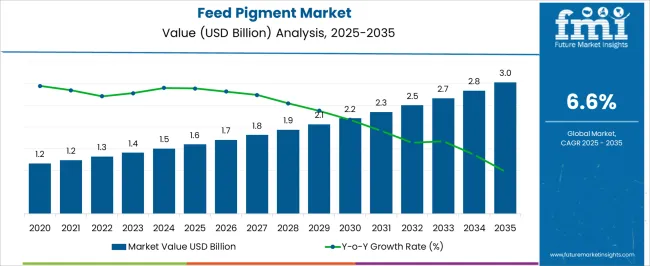
| Metric | Value |
|---|---|
| Feed Pigment Market Estimated Value in (2025 E) | USD 1.6 billion |
| Feed Pigment Market Forecast Value in (2035 F) | USD 3.0 billion |
| Forecast CAGR (2025 to 2035) | 6.6% |
The market is segmented by Type, Source, Livestock, and Application and region. By Type, the market is divided into Carotenoids, Curcumin, Spirulina, and Others. In terms of Source, the market is classified into Natural and Synthetic. Based on Livestock, the market is segmented into Poultry, Swine, Ruminants, Aquatic Animals, and Others. By Application, the market is divided into Poultry Skin Coloration, Egg Yolk Coloration, Fish Flesh Coloration, Pet Food Enhancement, and Others. Regionally, the market is classified into North America, Latin America, Western Europe, Eastern Europe, Balkan & Baltic Countries, Russia & Belarus, Central Asia, East Asia, South Asia & Pacific, and the Middle East & Africa.
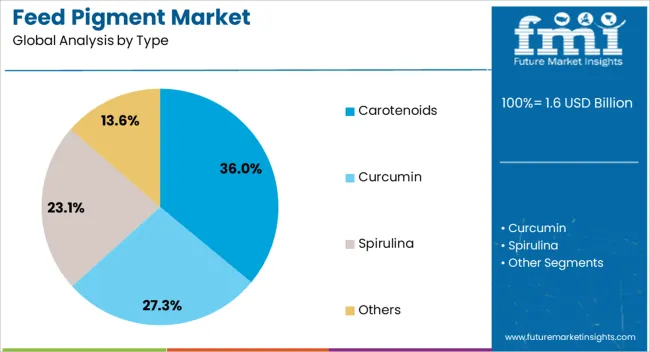
The carotenoids type segment is projected to hold 36.0% of the Feed Pigment market revenue share in 2025, making it the leading type. This growth is driven by the ability of carotenoids to improve coloration in animal products while providing antioxidant benefits that enhance animal health.
The increasing focus on natural feed additives has reinforced the adoption of carotenoids, as they align with consumer demand for safe and high-quality products. Their stability, efficacy, and compatibility with various feed formulations have further supported their leading position.
The segment’s growth is also aided by advancements in extraction and production technologies, enabling cost-effective and consistent supply Strong demand from the poultry sector, which requires vibrant egg yolk and skin coloration, has contributed significantly to the prominence of this segment.
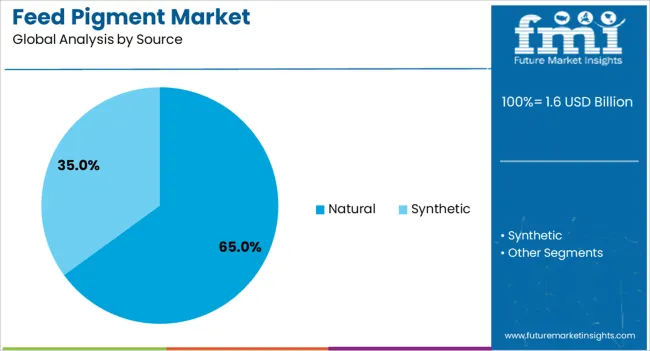
The natural source segment is expected to account for 65.0% of the Feed Pigment market revenue share in 2025, reflecting its dominant role in the market. Growth in this segment is driven by rising consumer preference for natural ingredients and regulatory support encouraging the use of non-synthetic additives.
Natural feed pigments provide safe and sustainable coloring options for livestock and poultry feed while supporting animal health. The shift toward clean label and organic farming practices has strengthened adoption, with feed manufacturers increasingly incorporating plant-derived and microbial pigments.
Furthermore, the superior acceptance of natural pigments in premium products has reinforced their market share, making this segment a key contributor to overall growth.
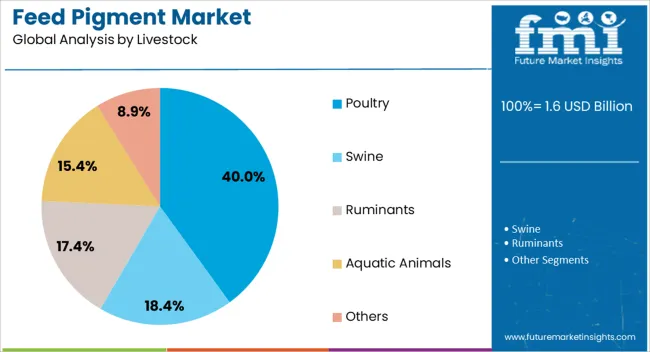
The poultry end-use segment is anticipated to hold 40.0% of the Feed Pigment market revenue in 2025, positioning it as the leading end-use industry. This growth is driven by the high demand for eggs and poultry meat with enhanced visual appeal and nutritional quality.
Feed pigments are widely utilized in poultry feed to achieve desirable yolk and skin coloration, which is highly valued by consumers. The expansion of poultry farming operations and intensification of production systems have further accelerated pigment adoption.
Additionally, advancements in feed formulations and the integration of carotenoids and natural pigments in poultry diets have strengthened their application The segment benefits from the increasing emphasis on product differentiation, food safety, and consumer-driven quality standards, which continue to drive the demand for feed pigments in the poultry sector.
Application in Precision Nutrition to Propel Demand
Feed pigments are being integrated into precision nutrition programs to optimize animal diets and enhance nutrient utilization, fueling growth. Precision feeding systems, including automated feeders and sensor-based technologies, control pigment inclusion levels, ensuring uniform distribution and targeted delivery for different animal species.
Innovations in Pigment Delivery Systems to Spur Sales
Developments in encapsulation and delivery technologies are transforming pigment formulations and applications. Techniques like microencapsulation and nanoemulsions enable controlled pigment release, improving stability, bioavailability, and shelf life. These innovations allow pigment incorporation into diverse feed matrices and production systems, thereby spurring demand.
Rising Focus on Sustainability and Traceability Augments Growth
The industry is prioritizing sustainability and traceability, aligning with animal nutrition trends. Manufacturers are adopting eco-friendly production methods and supply chain traceability to minimize environmental impact and meet ethical standards. Transparency and accountability are gaining traction in addressing consumer concerns and building trust in pigment sustainability.
Rising Competition and High Raw Material Cost in the Industry to Hamper Demand
Demand for natural feed additives is increasing, but synthetic pigments remain popular in the animal feed industry due to high cost-effectiveness and efficacy. Manufacturers of natural pigments face competition from synthetic alternatives, which is set to impact pricing and performance. Educating consumers about the benefits of natural pigments and addressing misconceptions is vital for differentiation in the sector.
Feed pigment production often involves natural sources like plants, algae, and microbial fermentation. However, fluctuations in raw material prices, environmental factors, and supply chain disruptions are set to increase input costs, affecting the profitability of pigment manufacturers. Sustainable sourcing practices and quality assurance measures are further projected to increase production costs.
The feed pigment market grew at a CAGR of 8% from 2020 and 2025. The sector reached USD 1.6 billion in 2025. Synthetic pigments were initially used to enhance animal feed color, but safety and health concerns led to regulatory changes and restrictions on use, fueling demand for feed pigment.
Natural pigments, such as beta-carotene, lutein, and zeaxanthin, gained popularity as alternatives to synthetic additives, offering safe and more environmentally friendly options. Furthermore, there was a growing demand for functional pigments with added health benefits for livestock and poultry.
Carotenoids and flavonoids are recognized for antioxidant properties, immune-boosting effects, and potential to improve animal performance and welfare. Technological developments in biotechnology, fermentation processes, and extraction techniques have transformed pigment production methods, leading to increased efficiency, purity, and cost-effectiveness.
Customization and tailored solutions have emerged as a result of the diversification of livestock species and the emergence of niche industries between 2020 and 2025. Pigment manufacturers now offer tailored formulations and blends to meet the unique requirements of different livestock categories. By 2035, the sector is set to surge at a CAGR of 6.6%.
Pigments are increasingly integrated into precision nutrition programs and feed formulations to optimize animal health, performance, and product quality. Sustainability and traceability initiatives are key priorities in the feed pigment industry, propelled by surging consumer demand for transparent and ethically sourced ingredients.
The following table shows the estimated growth rates of the leading markets. The United States is anticipated to remain at the forefront in North America, with a CAGR of 6.9% through 2035. In East Asia, Japan is projected to witness a CAGR of 8.3% by 2035, followed by China at 7.4%.
| Countries | CAGR 2025 to 2035 |
|---|---|
| United States | 6.9% |
| United Kingdom | 7.9% |
| China | 7.4% |
| Japan | 8.3% |
| South Korea | 9% |
The food sector in the United States is experiencing a surging demand for feed pigments due to rising consumer interest in healthy meals. Growing health concerns among the young population are further surging demand in the country.
Leading companies are strategically investing in research and development activities to provide a variety of products in the market. By 2035, the United States is projected to surge at a CAGR of 6.9%.
The United Kingdom is projected to rise due to changing lifestyles, increasing per capita income, and consumer preference for healthy food options. The country’s growing poultry business and high popularity of aquaculture also present growth opportunities for manufacturers.
Sustainability initiatives such as eco-friendly production practices to minimize environmental footprints and enhance global market competitiveness are gaining traction. The increasing population in the United Kingdom is pushing meat consumption, further boosting growth. During the forecast period, the country is projected to rise at a CAGR of 7.9%.
China is a key exporter of feed pigments, offering competitive pricing, efficient production processes, and abundant raw materials. The sector is regulated by government agencies such as the Ministry of Agriculture and Rural Affairs and the China Feed Industry Association, ensuring compliance with domestic and international standards.
Leading manufacturers are investing in technological innovations to improve production processes, product quality, and innovative formulations. Development in biotechnology, fermentation techniques, and extraction methods are fueling innovation in the country. By 2035, China is set to rise at 7.4% CAGR.
The section below analyzes the leading segment of the market. In terms of type, the carotenoids segment accounted for a 36% share in 2025. Based on the source, the natural segment held a market share of 65% in 2025.
| Segment | Carotenoids (Type) |
|---|---|
| Value Share (2025) | 36% |
Over the forecast period, demand for carotenoid type is forecast to rise at a CAGR of 6.4%. The segment is projected to lead the sector in the estimated years due to significant contribution to animal health and product quality.
A new type of concentrated carotenoid is being developed to help feedstuff formulators deliver required carotenoids to animals at any given time, further boosting the segment's growth. Astaxanthin pigment's acceptance among feed manufacturers is set to fuel growth as the product functions as a hormone precursor, preventing diseases and improving animal health.
| Segment | Natural (Source) |
|---|---|
| Value Share (2025) | 65% |
Natural sources significantly contribute to the industry, offering alternatives to synthetic additives and meeting the demand for clean labels and sustainable products. Various natural sources provide unique colorants and nutritional benefits for animals.
Plants, algae, microorganisms, yeasts, and seaweeds are all sources of natural pigments for animal feed. These pigments are set to be used in feed formulations for aquatic species and livestock. These are also anticipated to offer natural coloration, nutritional supplementation, and potential health benefits.
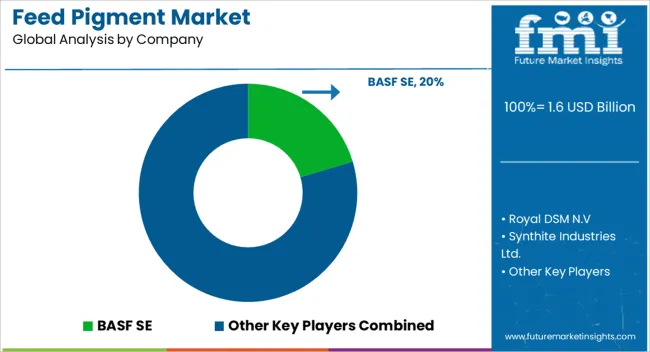
BASF SE, Royal DSM N.V., Kemin Industries, Inc., Novus International, Inc., and Synthite Industries Ltd. are key feed pigment manufacturers listed in the report. The market is highly competitive, with prominent enterprises focusing on innovation, sustainable sourcing, and research. Key manufacturers and companies are emphasizing extending geographical presence and product portfolios to gain a competitive edge.
Leading companies are further investing in research and development to broaden product lines, thereby boosting sales and demand. The main focus is on undertaking strategic activities such as new product launches, contractual agreements, mergers, acquisitions, high investments, and collaborations.
Key companies are focusing on environmentally friendly operations and product certifications to meet the growing demand for natural feed pigments. Leading manufacturers aim to improve market standing by focusing on client preferences, innovation, and quality.
Industry Updates
As per types, the industry has been categorized into carotenoids, curcumin, spirulina, and others.
In terms of sources, the sector is divided into synthetic and natural.
The sector is segmented into swine, poultry, ruminants, aquatic animals, and others.
A few of the important applications include egg yolk coloration, poultry skin coloration, fish flesh coloration, pet food enhancement, and others.
Industry analysis has been carried out in key countries of North America, Latin America, Western Europe, Eastern Europe, South Asia and Pacific, East Asia, and the Middle East and Africa.
The global feed pigment market is estimated to be valued at USD 1.6 billion in 2025.
The market size for the feed pigment market is projected to reach USD 3.0 billion by 2035.
The feed pigment market is expected to grow at a 6.6% CAGR between 2025 and 2035.
The key product types in feed pigment market are carotenoids, curcumin, spirulina and others.
In terms of source, natural segment to command 65.0% share in the feed pigment market in 2025.






Full Research Suite comprises of:
Market outlook & trends analysis
Interviews & case studies
Strategic recommendations
Vendor profiles & capabilities analysis
5-year forecasts
8 regions and 60+ country-level data splits
Market segment data splits
12 months of continuous data updates
DELIVERED AS:
PDF EXCEL ONLINE
Feed Additive Nosiheptide Premix Market Size and Share Forecast Outlook 2025 to 2035
Feeder Container Market Size and Share Forecast Outlook 2025 to 2035
Feed Machine Market Forecast Outlook 2025 to 2035
Feed Mixer Market Forecast and Outlook 2025 to 2035
Feed Grade Spray-dried Animal Plasma (SDAP) Market Size and Share Forecast Outlook 2025 to 2035
Feed Electrolytes Market Size and Share Forecast Outlook 2025 to 2035
Feed Micronutrients Market Size and Share Forecast Outlook 2025 to 2035
Feed Acidifier Market Analysis Size Share and Forecast Outlook 2025 to 2035
Feed Flavors Market Size and Share Forecast Outlook 2025 to 2035
Feed Enzymes Market Analysis - Size, Share, and Forecast Outlook 2025 to 2035
Feed Mycotoxin Binders Market Size and Share Forecast Outlook 2025 to 2035
Feed Phytogenics Market Size and Share Forecast Outlook 2025 to 2035
Feed Carbohydrase Market Size and Share Forecast Outlook 2025 to 2035
Feed Grade Oils Market Analysis - Size, Share, and Forecast Outlook 2025 to 2035
Feed Packaging Market Size, Share & Forecast 2025 to 2035
Feed Mycotoxin Detoxifiers Market Analysis - Size, Share, and Forecast Outlook 2025 to 2035
Feed Premix Market Analysis - Size, Share, & Forecast Outlook 2025 to 2035
Feed Phytogenic Market Analysis - Size, Share, & Forecast Outlook 2025 to 2035
Feed Attractants Market Analysis by Composition, Functionality, Livestock, Packaging Type and Sales Channel Through 2035
Feed Encapsulation Market Analysis- Size, Growth, and Forecast 2025 to 2035

Thank you!
You will receive an email from our Business Development Manager. Please be sure to check your SPAM/JUNK folder too.
Chat With
MaRIA